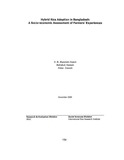| dc.contributor.author | Husain, A.M. Muazzam | |
| dc.contributor.author | Hossain, Mahabub | |
| dc.contributor.author | Janaiah, Aldas | |
| dc.date.accessioned | 2019-08-27T08:44:40Z | |
| dc.date.available | 2019-08-27T08:44:40Z | |
| dc.date.issued | 2000-12 | |
| dc.identifier.citation | Husain, A. M. M., Hossain, M., & Janaiah, A. (2000). Hybrid rice adoption in Bangladesh: a socio-economic assessment of farmers’ experiences. Research Reports (2000), Economic Studies, (XV), 154–206. | en_US |
| dc.identifier.uri | http://hdl.handle.net/10361/12492 | |
| dc.description.abstract | The study aimed at finding the farm-level adoption pattern, differential performances,
relative profitability and constraints to adoption of two hybrid rice varieties viz., Alok
6201 and Sonar Bangia (CNSGC 6). These varieties were introduced during 1999 Boro
season in Bangladesh. Findings show that farm size had a negative but education had a
positive effect on adoption rate. Grain yield of hybrids were 15% higher than that of
HYVs though Sonar Bangia did much better than Alok 6201. Input costs of hybrids were
23% higher. Profitability of Sonar Bangia was higher but that of Alok 6201 was lower
than that of HYVs. Constraints to hybrid rice adoption included external dependence and
higher seed cost, higher need for management skill, input intensity, higher incidence of
pests and diseases, inadequate yield gain and lower head-rice recovery. Special
constraints of A/ok 6201 include high rate of unfilled grain, grain shedding, crop lodging
and poor keeping quality of cooked rice. Stickiness of cooked rice and relatively inferior
quality in terrns of taste may also be considered as other constraints for boi.h varieties.
Some of these problems would have been avoided if, instead of introducing rice hybrids
without a clear deployment srategy, they were introduced to Bangladesh after scientific
on-farm testing for 2-3 seasons/years across agro-ecological regions.
Results tentatively imply that Alok 6201 may not be sustained for adoption. Though
Sonar Bang/a was highly profitable, its inferior quality may also inhibit growth in its
adoption in the long run. High quality local hybrids may be developed and domestic
production of hybrid seeds may be expedited. Hybrids for rain-fed environment and
resistant to biotic stresses may also be developed. Research infrastructure, scientific onfarm
testing of new hybrids before releasing them, integration of credit with extension
services, better management practices and co-ordination between public sector and
NGOs/private sector should be strengthened. | en_US |
| dc.language.iso | en | en_US |
| dc.publisher | Research and Evaluation Division, Brac | en_US |
| dc.subject | Hybrid Rice | en_US |
| dc.subject | Farmer | en_US |
| dc.subject | Socio-economic assessment | en_US |
| dc.subject | Alok 6201 | en_US |
| dc.subject | Sonar Bangia (CNSGC 6) | en_US |
| dc.subject.lcsh | Agriculture-- Bangladesh. | |
| dc.subject.lcsh | Economic assistance -- Bangladesh. | |
| dc.title | Hybrid rice adoption in Bangladesh: a socio-economic assessment of farmers' experiences | en_US |
| dc.type | Research report | en_US |
| dc.descriptionType.methods | Survey | |

